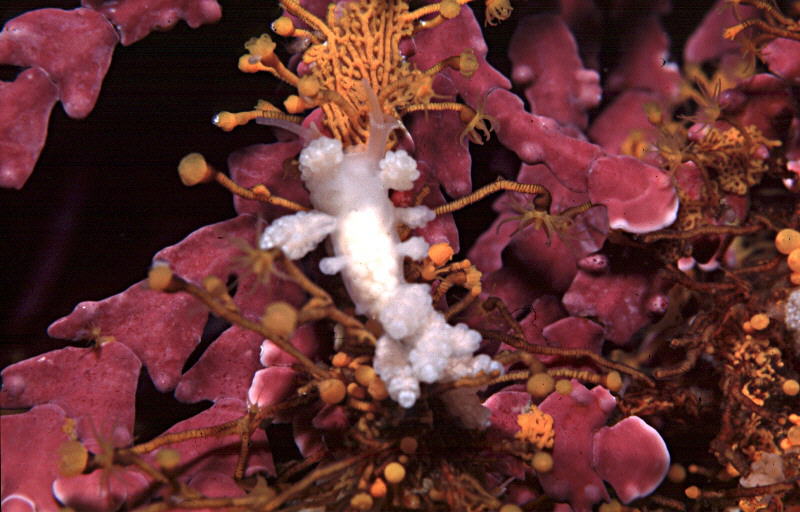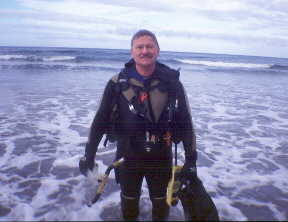 |
Doto amyra
Photo courtesy of Steve GardnerWilson's Rock, San Miguel Island, California
Jul. 2002
Doto amyra Marcus 1961
When present, this California dendronotacean is extremely abundant, as recently experienced by Steve, Bruce Wright and others diving the California Channel Islands. Initially most observers call this species an aeolid, but in fact it belongs to the Nudibranch suborder Dendronotacea because of internal anatomical differences and its unique pulpit-shaped rhinophores.
Members of the genus are difficult to ID, partially because of their small size and partially due to the variation in color between species. Because these specimens lack any dark pigment, I will call them Doto amyra .
Goddard (1996) provides an excellent study of the larval development of this species. In this paper he points out that D. amyra, as currently accepted may include at least two and possibly four distinct species. The following is a brief review of the distinctions Goddard reports for the four forms: "...Doto amyra Marcus, 1961 - Feeds on the hydroids Abietinaria sp., Garveia sp., Coryne sp., and Sertularia furcata and reaches a length of 14mm (averaging less than 10mm). The larvae are lecithotrophic. The body and head are translucent white and occasionally have an irregular scattering of fine-grain subcutaneous brown to black pigment. The five to eight pairs of cerata have pale yellow to light pinkish-orange or orange-brown colored cores. The cerata possess four to seven rings of tuberacles and lack dark pigment. The rhinophores are translucent and contain opaque white grains
Doto form A - Feeds on small athecate hydroids and measures up to 7mm. This form is similar in color to the previous, but with no dark pigment. It has five to six pairs of cerata, usually with orange to pinkish cores. Because of the presence of semi-translucent white glands in the tuberacles, they appear whiter that in the previous form. The larvae are planktotrophic.
Doto form B - This form occurs on Aglophenia. This form differs from the above two in having dark pigment on the cerata, which are smooth or bear only low tuberacles. Specimens lack the opaque white grains in the rhinophores. Goddard reports that this form is somewhat similar to D. columbiana O'Donoghue, 1921.
Doto form C (from La Jolla, CA) - Similar to Doto form A, above, it has planktotrophic larvae and feed on short unidentified hydroids..."
When I asked Jeff which one he thought Steve critters was, here is Jeff's reply "..Looks like what I've called Doto amyra , especially given the relatively large size of the developing embryos (form A has small embryos). Also, both Sandra (Millen) and I have seen Doto amyra feeding on Garveia , which is the hydroid in these (Steve's) photos...."
Just when you thought identifying nudibranchs was easy because of their striking color patterns, we get a curve thrown at us. What I have learned from Jeff's comment above is that we need to take a closer look at such things as the developing eggs/embryros seen in egg masses , and (within the body) of the nudibranch here, and the particular prey species, in this case the beautiful little yellow hydroid in the pic above, Garveia. Spectacular.
Reference:
Goddard, J.H.R. 1996. Lecithotrophic development in Doto amyra (Nudibranch: Dendronotacea), with a review of develop-mental modes in the genus. Veliger 39(1): 43-54.
Dave Behrens
Danville, Calif
Aug., 2002
Steve Gardner at La Jolla Shores (his backyard)

| Steve "bumble bee" Gardner as he is known to the regulars at La Jolla Shores was already a veteran diver/photographer when I joined the San Diego Underwater Photographic Society back in 1982. Steve has enjoyed great sucess with the Nikonos system he was using then and still is using now. California diving at times can be quite challenging with cold water and surge. " Washing machine " like water conditions almost make digital photograhy impossible and film photography marginal at best with a housed SLR, can be overcome by using framers! Using framers with a Nikonos was the solution for Steve then and still is the solution under such conditions. So don't despair all you aspiring U/W photographers! When contronted with the high cost of going with a housing either digital or film, you may want to consider looking for a used Nikonos with framers. Pick up an inexpensive strobe to go with it and you're in business at what can be a very reasonable price. Steve can usually be found diving at the Shores on the weekend but if you can't make it, you might want to visit his photo gallery to see all the unique animals Steve has photographed through the years.-Webmaster |
Steve can be contacted at stevebumblebee@san.rr.com
Taxonomic information courtesy of:

David W. Behrens
Author:
Pacific Coast Nudibranchs
Send Dave mail at seachalleng@earthlink.net
|
